Royal Clarence Hotel
The Royal Clarence Hotel is a hotel in Cathedral Yard, Exeter, Devon, England. It has been credited as the first property in England to be called a hotel. Since 2005 the 53-bedroom hotel[2] was branded as ABode Exeter.[3] The hotel along with surrounding buildings including 18 Cathedral Yard and The Well House Tavern were severely damaged by fire in October 2016. All of three damaged buildings are currently undergoing a major restoration. On 25 July 2017 restoration plans were unveiled by the hotelier Andrew Brownsword. The restoration work is being undertaken by construction consultants Thomasons, in partnership with Manchester architects Buttress, Historic England and Exeter City Council. On 6 August 2019, it was announced that Andrew Brownsword Hotels had put the site up for sale.[4] The reopening date is currently unknown.[5]
| Royal Clarence Hotel | |
|---|---|
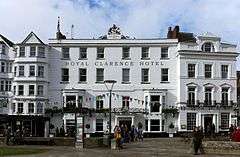 The hotel in 2015 | |
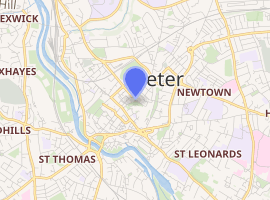
| |
| Former names |
|
| General information | |
| Type | Hotel |
| Address | Cathedral Yard |
| Town or city | Exeter |
| Country | England |
| Coordinates | 50°43′24″N 3°31′49″W |
| Named for | Adelaide, Duchess of Clarence |
| Opened | 1769 2024 (pending a sealed bidder three-year restoration process) [1] |
| Closed | 28 October 2016 |
| Demolished | November 2016 |
| Owner | Andrew Brownsword Hotels[2] |
| Designations | Grade II listed |
| Other information | |
| Number of rooms | 53 bedrooms[2] |
| Website | |
| www | |
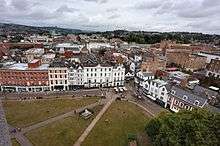
History
Before the Reformation, the land which was to become the site of the hotel was part of the accommodation for Exeter Cathedral's Vicars choral. The site was later leased to a variety of tenants until in March 1766 the Reverend John Lee of Lympstone assigned the lease of the premises that he held there to William Mackworth Praed (1747–1833).[6] Praed was a son of William Mackworth Praed, a lawyer and politician who had died in 1752.[7] At the time of the transfer, part of the premises leased by John Lee was occupied by an under-tenant, a French school master named Peter Berlon, and Praed engaged him to manage the planned development of the site. Praed acquired other adjacent premises too, including the freehold of a property half way along St Martin's Lane, and dilapidated property in High Street, which he redeveloped separately.[8] He also developed the adjacent building on the corner of St Martin's Lane for the Exeter Bank, of which he was one of the founding members, with John Duntze, Joseph Sanders and Daniel Hamilton.[9]
It appears that work proceeded quickly on the hotel site because in early September 1766 a newspaper article referred to there having been "an Assembly at Mr Berlon's New Room" accompanied by "some curious Fireworks in the Churchyard". In August 1767 there was a newspaper notice of an entertainment to take place at "Mr Berlon's new Assembly-Room". By March 1768 Berlon was advertising his business as "Berlon's Coffee-house" and in November that year he announced that he had "lately fitted lodgings, for the conveniency of those Gentlemen and Ladies who please to honour him with their Favours".[10]
In September 1770, Berton placed an advertisement for the business, describing it as "New Coffee-house, Inn, and Tavern, Or, The Hotel, In St. Peter's Church-yard, Exeter." This is possibly the first use of the word hotel in England.[11]
According to Alexander Jenkins, writing in 1806, the hotel provided "a commodious room for holding public balls, assemblies, concerts, &c.".[12] Jenkins further described it as:
a large and commodious Inn, with elegant apartments and accommodation for people of the first Quality, with a large assembly-room in which are held the Assize Balls, Concerts and Winter assemblies, of the most distinguished persons of the City and County. In the front is a neat Coffee-room: the situation of the Hotel is very pleasant, as it opens to the Parade, and commands a noble view of the Cathedral.[13]
It subsequently took various names, including the Cadogen Hotel, Thompsons Hotel, and Phillips Hotel.
The hotel became one of the leading coaching inns in Exeter. It was visited by Admiral Nelson in 1801,[14] and was renamed as the Royal Clarence Hotel after a visit by Adelaide, Duchess of Clarence in July 1827. Franz Liszt performed with six other musicians in two concerts at the hotel on 28 and 29 August 1840[15] (a blue plaque on the building, erected by Exeter Civic Society in 2013, commemorated that event[16]). Other visitors included Beatrix Potter in 1892, Thomas Hardy in 1915, and actors Clark Gable and Gary Cooper during the Second World War.[14]
Between 2000 and 2015, the hotel was co-owned and run by celebrity chef Michael Caines, who set up ABode with business partner Andrew Brownsword.[17] Brownsword bought the hotel in 2003 for £4.5 million.[2]
Building
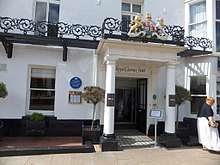
There was a range of medieval buildings on the site of the present buildings in Cathedral Yard. Some elements of these were retained in later reconstruction: the party wall between the Royal Clarence Hotel and the next property includes the remains of a 15th or 16th-century timber-framed side wall, two storeys high, belonging to a former building with roof line parallel to the street.[18][19] The original 1769 building was partly remodelled in the Egyptian style in 1827,[20] when it was also extended to incorporate the former Exeter Bank building adjoining Martin's Lane.[21] Later alterations considerably changed the interior,[20] though it retained its timber framing. It gained listed building status (Grade II) in 1953 as part of the group of listed buildings in Cathedral Yard.[22]
2016 fire

On 28 October 2016 the hotel was gutted by a fire which began at 5 a.m. in an adjoining building part-used as an art gallery (the Castle Fine Art gallery), which was being converted at the time into luxury flats.[23] Hotel guests were evacuated to the nearby Mercure Southgate Hotel, and no casualties were reported.[24] The fire was later fuelled by a ruptured gas main,[25] and part of the frontage of the building collapsed.[26] The interior of the grade II listed building where the fire started, 18 Cathedral Yard,[27] was also destroyed, and the two listed buildings between were damaged,[28][29] but firefighters prevented the fire spreading to other historic buildings. Over a hundred firefighters attended the incident and it was necessary to draw water from the River Exe to fight the fire. The people of Exeter helped by giving the firefighters free food and messages of support, and by limiting their use of water.[30]
Restoration
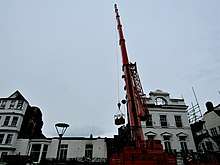
After assessments were completed and remaining hotspots extinguished,[31] demolition of the building started on 2 November,[32] but there are efforts to salvage historically important material from the wreckage.[33] The Christmas market in Cathedral Green has made provision for the independent traders who were closed since the fire.[34] The hotel's owner, Andrew Brownsword, said on 31 October: "We have every intention to rebuild the hotel with enormous sympathy to its importance and heritage, and to make it once again a building that the City of Exeter will be proud of."[35] A laser survey of the Royal Clarence made two years before the fire could help architects reconstruct the facade and the hotel.[36] On 22 February 2017 archaeologists involved in the restoration and rebuilding of The Royal Clarence Hotel unearthed medieval pictures, including one of a peacock. It is estimated it will take three months to complete the deconstruction of the building, with every effort being made to save as many historical features as possible. It will take a total of 21 months to restore the façade of the building and a modern design for the interior of the hotel.[37] On 25 July 2017 official restoration renovations plans were unveiled for the exterior frontal facade. Further plans are still underway for the interior of the hotel.[38] On 6 August 2019 it was announced that Abode the chain that owns the hotel, had put the site of the Royal Clarence Hotel up for sale. This is due to financial reasons citing unable to afford the completion of significant repairs the building. The demolition works the debris of the fire were cleared. The restoration work to the surviving interior historic fabric of building including chambers were strengthened and repaired. The site is now ready for the next stage of restoration and repair works of the hotel when a buyer is announced.[39] On 8 November 2019 it was reported that 18 Cathedral Yard had now been repaired having undergone a three-year complete restoration undertaken by the same restorers who restored Windsor Castle following the 1992 fire in Berkshire, which was completed in November 1997. There is now a second round of bids for the sale and restoration work to complete the repairs of The Well House Tavern Pub and The Royal Clarence Hotel.[40]
References
- "16-17 Cathedral Yard And Royal Clarence Hotel Cathedral Yard Exeter Reconstruction". Exeter City Council. 5 December 2019. Retrieved 14 November 2019.
- Janet Harmer, "Andrew Brownsword speaks of devastating loss of Royal Clarence hotel", The Caterer, 29 October 2016. Retrieved 30 October 2016
- ABode Exeter. Retrieved 28 October 2016
- "Royal Clarence Hotel fire: Exeter site put up for sale". BBC. 6 August 2019. Retrieved 13 August 2019.
- "The Royal Clarence Hotel reveals plans for restoration after last year's fire". Boutique Hotelier. 26 July 2017. Retrieved 26 August 2017.
- Marsh (2017), pp. 1–3.
- Griffiths, Grace (1989). History of Teignmouth (3rd ed.). Bradford on Avon, Wiltshire: Ex Libris Press. p. 77. ISBN 0-948578-17-3.
- Marsh (2017), pp. 3–7.
- Ryton, John (1984). Banks and Banknotes of Exeter 1769-1906. Exeter: John Ryton. p. 23. ISBN 0-9508666-0-1.
- Marsh (2017), p. 25.
- Marsh (2017), p. 27–8.
- Jenkins (1806), p. 213.
- Jenkins (1806), p. 317.
- The Royal Clarence Hotel, Cathedral Close, Exeter Memories, 12 December 2008. Retrieved 28 October 2016
- Harvey, Hazel (2011). The Story of Exeter. Phillimore. p. 129. ISBN 978-1-86077-678-6.
- Plaque #13098 on Open Plaques.
- "Michael Caines MBE: 'Did cuts hinder Royal Clarence fire crews?'", Express & Echo, 28 October 2016 Archived 30 October 2016 at the Wayback Machine. Retrieved 30 October 2016
- Parker, Richard; Allan, John (2015). "The Transformation of the Building Stock of Exeter 1450-1700". In John Allan; Nat Alcock; David Dawson (eds.). West Country Households 1500–1700. Boydell Press. pp. 51–2. ISBN 978-1-84383-994-1.
- Jane Mathews , "Royal Clarence Hotel in Exeter starts to collapse following blaze", The Telegraph, 29 October 2016. Retrieved 30 October 2016
- Meller, Hugh (1989). Exeter Architecture. Chichester: Phillimore. p. 23. ISBN 0-85033-693-7.
... now, behind the stucco facade, the only faintly discernible style is Edwardian.
- Cherry, Bridget; Nikolaus Pevsner (1991). Devon. New Haven, CT: Yale University Press. pp. 413–414. ISBN 0-300-09596-1.
- Royal Clarence Hotel, British Listed Buildings. Retrieved 28 October 2016
- "Exeter fire: Gutted building was being converted into luxury flats", "Exeter Express and Echo", 28 October 2016 Archived 29 October 2016 at the Wayback Machine. Retrieved 28 October 2016
- "Luxury Hotel in Exeter City Centre – ABode Exeter". Archived from the original on 17 November 2016.
- "Exeter fire: Royal Clarence Hotel collapses in blaze". BBC News. 29 October 2016. Retrieved 26 November 2016.
- "Exeter fire: Royal Clarence Hotel collapses as blaze rages", BBC News, 29 October 2016. Retrieved 29 October 2016
- "Architecture experts mourn loss of "irreplaceable" interior in building where fire started", Express & Echo, 29 October 2016. Retrieved 29 October 2016
- Gale, Damien (29 October 2016). "Exeter fire: little of historic Royal Clarence Hotel remains". theguardian.com. Retrieved 27 November 2016.
- Exeter blaze destroys hotel thought to be oldest in Britain The Guardian
- Royal Clarence fire: demolition to begin as firefighters thank Exeter public The Guardian
- "Royal Clarence fire: Engineers assess fire-ravaged hotel". BBC News. 30 October 2016. Retrieved 30 October 2016.
- "Royal Clarence Hotel in Exeter demolished after blaze", BBC News, 2 November 2016. Retrieved 2 November 2016
- Historic Remains will be Salvaged from Royal Clarence Hotel Wreckage
- Exeter's Christmas Market to go ahead after huge fire ITV
- Martin Fullard, "Royal Clarence Hotel owner has “every intention to rebuild” after fire", Conference News, 31 October 2016. Retrieved 31 October 2016
- Laser survey could help rebuild Royal Clarence Hotel BBC
- "Royal Clarance Hotel could reopen in 21 months". Devon Live. 22 February 2017. Retrieved 2 March 2017.
- "Fire-hit 'oldest hotel in England' restoration unveiled". BBC News. 25 July 2017. Retrieved 25 July 2017.
- "Royal Clarence Hotel fire: Exeter site put up for sale". BBC News. 6 August 2019. Retrieved 24 August 2019.
- "Company confirms it has made an offer for Exeter Royal Clarence fire site - but doesn't have hotel plans". Devon Live. 8 November 2019. Archived from the original on 8 November 2019. Retrieved 13 November 2019.
Sources
- Jenkins, Alexander (1806). The History and Description of the City of Exeter, and its Environs, Ancient and Modern, Civil and Ecclesiastical. Exeter: P. Hedgeland.
- Marsh, Darren (2017). Exeter's Royal Clarence Hotel. Exeter: The Devon and Exeter Institution. ISBN 978-0-9930172-2-3.
Further reading
- Dymond, R. (1904). "Old Inns and Taverns of Exeter". In F. J. Snell (ed.). Memorials of Old Devonshire. Bemrose and Sons Ltd. pp. 74–76. Provides more early history of the hotel, its owners, visitors, etc.
External links
| Wikimedia Commons has media related to Royal Clarence Hotel, Exeter. |